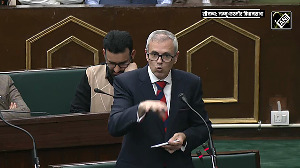Market experts try to explain the reasons why some stocks did well and why some didn't, and what investors should do now.
The BSE Sensex reached its peak of 12,612.38 on May 10, 2006 and investors were hoping that it would soon cross the 13K mark.
But since then, the market started falling and on June 14, 2006, the Sensex touched 8,929.44 points, which was breached in December 2005. This way, all the market gains of 2006 evaporated.
The market has now clawed back from the lows, and managed to cross the 10K level. With the markets recovering again, it is time to see how some of the Sensex stocks have done, and what investors can expect in the future.
Stocks that fell...
After the correction till June 14 and the subsequent recovery, Hindalco, Tata Steel, ONGC, Dr Reddy's and Ranbaxy are some of the stocks that have fallen the most.
Though stocks like Reliance Communication, L&T and HLL were among the top five losers between the Sensex high and low of 2006, they have managed to stage a smart recovery after June 14.
Explaining the fall in L&T, Mihir Vora, head, equities, ABN Amro Mutual Fund says, "Construction and capital goods which were hot favourites in the first half of the year faced more selling as trading interest was high."
In case of Reliance Communication, Jignesh Desai, AVP institutional sales, Networth Stock Broking says, "FIIs got this stock due to the de-merger of Reliance Industries and some of them booked profits at every stage."
Metal stocks, like Hindalco and Tata Steel, too were among the top five losers but they recovered quickly. "Metal stocks were more volatile because of their correlation with metal prices in the international markets," says Deepak Jasani, head of retail research, HDFC Securities.
As a result, Tata Steel and Hindalco had declined 40 per cent till June 14. After this date, Tata Steel delivered returns of about 27 per cent and Hindalco 19 per cent.
Explaining this recovery, Raamdeo Agrawal, joint managing director, Motilal Oswal says, "These stocks fell too much because of falling commodity prices and panic among shareholders. Now, the panic has lifted, so the rate of recovery is faster. Also, where the panic is maximum, rebound is maximum too."
Certain stocks like ONGC, Ranbaxy, Dr Reddy's fell the most since the peak on May 10 but they were not able to recover much.
"Stocks like Ranbaxy and Dr Reddy's are trading at historically high P/E multiples than their past average. The market crash was severe for high P/E stocks," says Jigar Shah, director, KR Choksey.
In case of ONGC, Jasani says, "The latest formula on sharing of oil subsidy has resulted in higher losses for the company."
...And those that did relatively better
Among the stocks that did not fall as much are Infosys, NTPC, Bharti, Hero Honda and Satyam Computer. IT stocks declined to a lesser degree from the peak till the fall and even during the market recovery period, they delivered good returns.
"IT stocks are now looked upon as defensive stocks because of the visibility in earnings and the recent weakening of rupee vis-à-vis dollar," says Jasani.
"However," he adds, "any negative cues on US corporate growth could result in a sharp sell-off in these stocks."
Explaining the low fall in IT stocks, Vora says, "Overall, the tech sector had underperformed earlier in the year and to that extent there was over-ownership at the retail level."
Stocks like Bajaj Auto, NTPC, HDFC Bank and Bharati too did not fall much from the peak. In the case of Hero Honda and Bajaj Auto, there is earnings visibility as the volume growth remains robust.
Explaining the reason for the lower fall in HDFC Bank, Desai says, "HDFC Bank is a leader in its segment. If any fund house wants to buy a banking stock, this stock would be its first pick. Bharti too is a leader in its segment with high subscriber base, so it has fallen less."
Shah feels that besides the higher visibility, the P/Es of stocks like NTPC, Bharti, Hero Honda and Bajaj Auto have been in line with the growth.
What's the market looking for?
The market faced a number of ups and downs in the last few weeks. Due to this volatility, investors have panicked and are worried as to what they should do now.
Is it better to move to defensive sectors? But the definition of defensive sector keeps changing. For example, the pharma sector is generally considered defensive as the demand for medicines is not going to change irrespective of the economy, but market experts believe that investors should avoid pharma stocks at present as the P/Es are very high.
This time around, there is a clear preference for sectors where there is visibility in earnings and valuations are relatively cheaper. Also, the recent weakening of the rupee vis-à-vis the dollar means that exporters are going to benefit.
Sandeep Sabharwal, CIO Equity, Lotus India AMC says, "Now, stocks have corrected a lot. I feel investors should look for stocks that are cheap relative to the market and have strong growth." Some experts who have faith in the Indian markets consider this correction as an opportunity to buy.
"Life does not change in 20 days and I think this is the best time to buy. Investors should not worry as India has a strong growth story. Investors should invest in companies that have a good management and are available at reasonable prices," says Agrawal.







 © 2025
© 2025